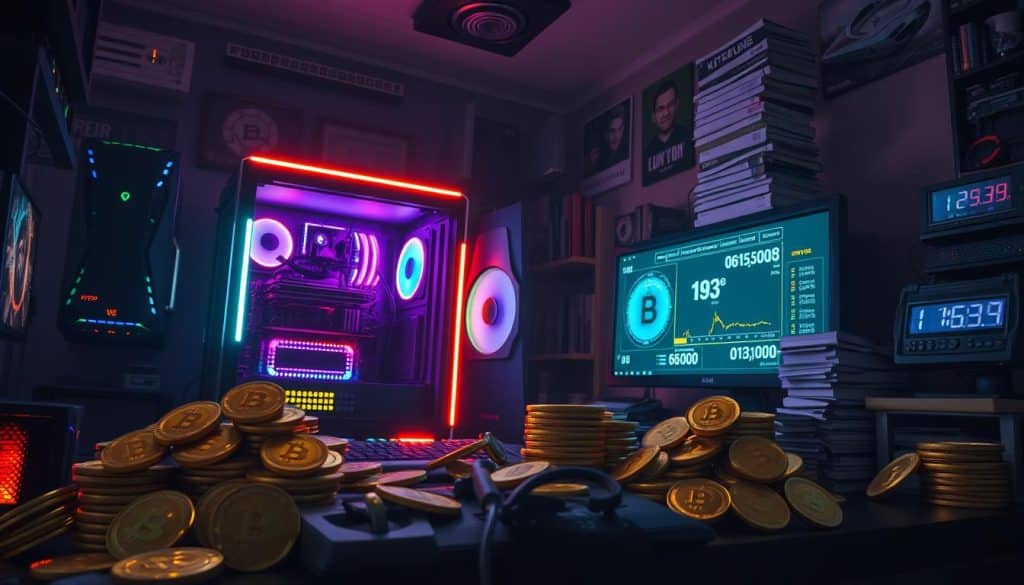In August 2025, the Bitcoin network hit a mining rate of 622 exa-hashes per second1. Though your gaming PC can run top-level games, it’s not cut out for Bitcoin mining. The main issue is that Bitcoin mining needs solving tough math puzzles to check transactions and mint new coins, ideally done by specialized ASIC miners2. Your gaming PC’s GPU, while great for games, can’t keep up with the demanding algorithms needed for mining, making it a poor choice for this task.
Bitcoin mining’s competitiveness makes it tough for gaming PCs to earn profits3. Large mining operations dominate, pushing small players out. If your gaming PC is secretly mining cryptocurrencies, you might notice it performing poorly and using more electricity. This situation highlights the big differences in hardware needed for mining versus gaming. In this article, we’ll explore why gaming PCs struggle with mining and what you can do. We’ll also discuss whether investing in mining-specific hardware is a smarter choice.
Key Takeaways
- The Bitcoin network mining rate was around 622 exa-hashes per second in August 20251.
- Gaming PCs are not optimized for the complex, sustained work involved in Bitcoin mining2.
- Competitiveness in Bitcoin mining is dominated by professional miners and large-scale operations3.
- Cryptocurrency mining can significantly increase energy consumption and reduce hardware lifespan2.
- Understanding gaming PC limitations can help optimize its performance and mitigate unnecessary strain2.
Understanding Bitcoin Mining
Bitcoin mining plays a key role in keeping the cryptocurrency network up and running. Miners verify transactions and solve tough math problems. This keeps the Bitcoin network safe and secure. They do this through the Bitcoin mining process.
The Basics of Bitcoin Mining
Miners tackle complex math puzzles using powerful equipment and programs. A miner’s chance to find the solution relates to the network’s total mining power3. Solving these puzzles creates new blocks in the blockchain, rewarding miners with Bitcoin. In 2009, miners got 50 BTC, but by April 2025, it dropped to 3.125 BTC3.
Miners use special graphics cards or circuits to mine3. The mining challenge shifts every two weeks or after 2,016 blocks, which keeps mining ever-changing1.
Why Bitcoin Mining is Popular
Many people are drawn to mining for its potentially high rewards. On March 8, 2025, Bitcoin hit over $70,000, with a closure at $68,2853. Despite the mining reward halving, the competitive drive remains strong. The last halving in April 2025 cut rewards to 3.125 bitcoins1.
Helping maintain the Bitcoin network also motivates many miners. Yet, large mining groups largely control mining power, showing this field’s competitiveness3. Mining with common computers brings meager returns compared to advanced ASIC systems1.
The mining difficulty number was 79.35 trillion on March 9, 2025. It climbed to 92.67 trillion by September 15, 202531.
Knowing the details of Bitcoin mining is vital for anyone looking to dive in or grow in this area. Whether for profits or to support the network, Bitcoin mining’s allure keeps rising.
GPU Mining vs. ASIC Mining
In the world of cryptocurrency mining, you’ll find two main hardware types: GPU and ASIC miners. Knowing their pros and cons is key for mining success.
What is GPU Mining?
GPUs, or graphic processing units, are used in computers to mine cryptocurrencies. They’re popular because they’re versatile. On top of mining, GPUs handle different tasks, making them adaptable4. The demand for GPUs shot up mainly because of Ethereum mining. This led to a shortage and higher prices5.
Ethereum is tough for ASICs to mine because it needs a lot of memory. Thus, GPUs are still useful for it5. Some GPUs can’t mine Ethereum due to memory limits. But, they can still profit from other coins4.
Advantages of ASIC Miners
ASIC miners, or Application-Specific Integrated Circuits, are built just for mining. They are super efficient and can lead to big earnings. A top Bitcoin ASIC is 100,000 times faster at hashing than the best CPU5. Their fast speed means they can be very profitable. Even if an ASIC costs $3000, it could earn about $10 profit in the first month5.
Setting up and using ASICs is easy, making them user-friendly compared to GPUs4. But, they’re simple, which means more competition and maybe less money over time4. The shift towards Ethereum’s Proof of Stake is also something to watch for both ASIC and GPU miners4.
| Criteria | GPU Mining | ASIC Mining |
|---|---|---|
| Hash Rate Efficiency | Lower but versatile | Extremely high |
| Cost | Varies, typically cheaper | Expensive (around $3000) |
| Setup Complexity | More challenging | Simple |
| Use Case | Various tasks, multiple coins | Specific to one coin |
| Potential Earnings | Varies depending on the coin | High, depending on the miner |
Choosing between GPU and ASIC miners depends on your mining goals and needs. Both have benefits worth considering.
Cryptocurrency Mining Rigs
Creating a crypto mining rig takes careful planning and the right gear. You need to pick the best parts and think about costs. A proper mining rig setup can make a big difference in your profits.
Building a Mining Rig
For a mining rig, gather: a motherboard, graphics cards, power supply, cooling, CPU, and a solid frame. GPU rigs are a favorite because they offer good power without costing too much6. High-end graphics cards can be expensive and add to your mining rig expenses7. It’s also vital to know the hashrate, which shows how powerful your rig is and its efficiency6.
Cost Analysis of Mining Rigs
When looking at investment in mining, think about both the upfront and ongoing costs, like electricity. Crypto demand drives GPU prices up. For example, used GeForce 1070 GPUs once went for $400 to $500 on eBay, way over their original price7. In 2018, prices for mid-range GPUs spiked nearly to $200 because of high demand8. Also, a special 80+ Platinum 2200-watt power supply for mining rigs shows the unique costs of crypto mining8.
| Component | Estimated Cost | Notes |
|---|---|---|
| Motherboard | $150 – $400 | High-PCIe slot motherboards are preferred8 |
| Graphics Cards (GPU) | $400 – $1,200 | Prices fluctuate based on demand7 |
| Power Supply | $100 – $400 | Higher wattage required for full rigs8 |
| Cooling System | $50 – $200 | Essential to prevent overheating |
| CPU | $100 – $300 | Basic models usually suffice |
| Mining Rig Frame | $50 – $150 | Sturdy frames support multiple GPUs |
Mining Hardware Requirements
To mine cryptocurrency well, you need the right tools. Your gaming PC might be strong for playing games, but it probably isn’t cut out for mining. To mine effectively, think about things like GPUs, cooling systems, and solid power sources.
The NVIDIA GeForce RTX 30 series and AMD Radeon RX 6000 series are top for mining, thanks to their high hash rates and low energy use9. A modern, powerful processor, like Intel’s Core i7 or AMD’s Ryzen 7 series, keeps your mining setup running smoothly9.
For mining, the ASUS Prime Z390-P and the Gigabyte B550 Aorus Pro are great motherboard picks9. Power supply units from Corsair, EVGA, and Seasonic are trusted for mining9. You’ll want at least 8GB of DDR4 RAM9 and a 240GB SSD or bigger for fast startups and storage9.
Keeping things cool is key. You should have lots of case fans, good CPU coolers, and GPU cooling setups for your mining rig9. Tweaking GPUs to work harder while using less power can make mining more effective9.
Fast internet is a must for keeping up with the crypto network9. Good cooling and things like risers help your mining rig work better9. Joining a mining pool can boost your earnings by combining power with others10.
Keeping your rig clean and software up to date makes it last longer and work better9. Think ahead by getting a motherboard and power supply that can grow with your rig9.
For more tips on mining hardware, check out this link.
Bitcoin Mining Profitability
Profitability in Bitcoin mining depends on key factors. This includes hardware efficiency, electricity costs, and mining difficulty. Let’s dive into what affects Bitcoin mining profits and how to calculate mining returns.
Factors Affecting Bitcoin Mining Profitability
The main things affecting mining profits are electricity costs, hardware efficiency, and market changes. For example, Bitcoin’s price swung from $4,107 in 2020 to $73,750 in March 202511. This volatility can greatly influence how much miners make. Also, Bitcoin mining uses a lot of power — more than entire countries like the Netherlands or the Philippines11.
Choosing the right mining equipment is also critical. Miners have options like the Antminer or Whatsminer, which vary in price and speed12. Miners need to weigh the costs and benefits, including the gear’s price, power consumption, efficiency, and time, to find their break-even point12.
Calculating Potential Earnings
There are tools to estimate how much you might earn from mining. For instance, the Antminer S19 XP calculator can show when you might start making a profit. This is based on electricity costing $0.13 per kWh and the pay-per-share payout method12.
Calculating earnings first can reduce the risk of losses and raise earnings chances. Solo miners, especially, face long odds, like the 1 in 26.9 million chance of solving a Bitcoin hash with limited power11. Knowing these factors and using profitability tools is crucial in the unpredictable world of Bitcoin mining.
Crypto Mining Calculators
Crypto mining calculators are essential for anyone in cryptocurrency mining. They help you figure out potential profits considering hash rate, power use, and hardware costs. These tools guide your mining choices with detailed earnings estimates.
These calculators assess how profitable different mining hardware is. For example, a GeForce 1070 GPU can mine about 23 MH/s, making roughly 0.022 Ethereum a month. If 1 ETH equals about $2,500, as it did in April 2021, you’d earn around $55 a month. But after $20 for electricity, your real profit drops to $357.
In 2021, ETH prices jumped, at one point increasing from $2,500 to $3,800 in just 17 days. With an updated mining rate, your monthly earnings could hit $117. After electricity, your profit is about $977. This shows how vital up-to-date calculators are. Your mining’s success can shift quickly with the market.
It’s smart to consider your hardware’s hash rate and power use too. The NVIDIA GeForce RTX 3060 Ti GPU, for example, has a 60 MH/s rate and uses 200W. The GeForce GTX 1070 Ti GPU does 35 MH/s and uses 95W13. A calculator can show which setup is best for both profit and energy use.
Cloud mining adds more options, with over 20 choices, from free to paid plans14. These online mining services use tight security and have clear prices14. They also update mining contracts based on current Bitcoin prices and network rates, helping you get the most from your investment14.
Using crypto mining calculators enhances your mining strategy. Enter your hardware’s details and these calculators provide precise forecasts to improve your plans.
| Hardware | Hash Rate (MH/s) | Power Consumption (W) | Monthly Profit ($) |
|---|---|---|---|
| GeForce 1070 | 23 | 150 | 357 |
| RTX 3060 Ti | 60 | 200 | Varies13 |
| GTX 1070 Ti | 35 | 95 | 4513 |
Challenges of Mining With a Gaming PC
Mining with a gaming PC might seem good, but it’s not easy. Problems like hardware not being strong enough, using too much power, and getting too hot can make it hard and bad for your PC.
Hardware Limitations
Gaming PCs use GPUs which can work super fast, up to 800 times faster than CPUs15. But ASIC miners do even better, reaching speeds that GPUs can’t match and using less power15. That’s why gaming PCs struggle to keep up in mining today. Companies making GPUs, like Intel, Nvidia, and AMD, now have to deal with these powerful ASICs and other specialized tech, making it tough for gaming PCs15.
Energy Consumption
Mining on a gaming PC uses a lot of power. It can be as much as a small country uses1. Mining makes a PC very hot, needing more coolers and energy1. Big mining setups sometimes pay $80,000 a month for electricity before they shut down2. This makes mining not worth it for regular gaming PCs.
Potential Overheating
When you mine for a long time, your PC can get too hot. This heat can damage it and make it not last as long2. Cryptojacking can also make your PC overheat without you knowing, raising your bills and making your PC slow2. That’s why it’s important to keep your PC cool and check it regularly.
Why Your Gaming PC Sucks at Bitcoin Mining (And What to Do About It)
Many gamers notice their PCs can’t handle Bitcoin mining well. This is mostly because of the hardware and complex mining algorithms. Even though GPUs like the Radeon HD 5970 are powerful, ASIC miners are more efficient today15. But, there are ways to make your gaming PC better at mining.
One method is to upgrade your PC’s hardware. Adding better cooling systems can help avoid overheating. This allows it to perform well for longer. Also, using GPUs with more ALUs can improve mining efficiency15. Intel, Nvidia, and AMD make these powerful GPUs15.
Adjusting your software can help too. Tailoring mining software to fit your hardware can boost performance. Nvidia is working to make gaming GPUs better at mining. They are doing this while making sure gamers still get enough GPUs. They introduced CMP chips for miners16.
Mining uses a lot of energy, and cryptojacking has made it worse. Complex puzzles and high energy costs mean PCs are not the best for mining anymore. Devices like FPGAs and ASICs are designed for efficient mining. They often outdo gaming PCs15.
Nvidia’s CMP cards, made for mining, have sold well. This shows the need for special hardware to mine effectively. Nvidia’s CMP card sales even outdid their automotive business16. Gamers should understand and adapt to these trends to improve their mining.
Large mining setups now use advanced video cards. ASIC-resistant tokens keep GPU mining alive. But, ASICs often beat GPUs in mining efficiency15. Knowing this and using the right upgrades and software can make your PC mine better.
For those interested in decentralized database networks and blockchain, visiting cryptocurrency and blockchain technology websites can help. Staying updated on tech advances can maximize your gaming PC’s mining abilities.
How Mining Difficulty Impacts Your Gaming PC
Bitcoin mining is growing in popularity, making the problems miners face harder to solve. This can seriously affect how well your gaming PC works and how long it lasts.
What is Mining Difficulty?
Mining difficulty measures how hard it is to find a new block for the blockchain. It keeps blocks coming at the regular pace of every 10 minutes. This system needs powerful ASIC miners, leaving gaming PCs unable to keep up. Learn more about the challenge17.
Impact on Hardware Performance
The increase in mining difficulty can overwork your PC’s gaming hardware. This can lead to several problems:
- Parts like your GPU and CPU may wear out faster.
- Your PC might use a lot more electricity, making your bills higher than expected18.
- There’s a bigger chance your PC could overheat if its cooling isn’t good enough.
On top of that, mining can become less profitable over time, raising your operating costs. For one setup, the initial cost was around 5000 euros, with monthly electricity costs of 220 euros17. Plus, due to higher difficulty and energy use, earnings dropped by 25% for one miner18.
If you’re thinking about mining with a regular PC, understand these challenges first. You need to think carefully if the possible money you can make is worth the extra strain and costs on your hardware.
Mining Rig Optimization Tips
Getting the most out of your mining rig is key for top-notch efficiency in crypto mining. By focusing on improvements and efficient cooling, you can boost your hardware’s performance and its life.
Improving Efficiency
To enhance your mining efficiency, tweaking your graphics card settings is essential. Finding the right mix of hash rates and power use is key for good results. Cards like the 1080ti, 1070ti, and 1060 are great for mining, giving strong performance for their price, even when costly19. A decent GPU mining rig, costing about $3,000, can be both efficient and somewhat budget-friendly for those starting out20.
Controlling power use is crucial for better mining rig performance. High power use not only ups operation costs but also affects the environment. Some miners suggest using eco-friendlier options, like Proof of Stake (PoS), to lessen the impact19.
Cooling Solutions
Good cooling methods are key to keep your mining rig running well. Heat can cause hardware to fail, shortening its lifespan. Miners use extra fans or switch to liquid cooling to keep temperatures down. This helps keep your equipment performing well.
Mining generates a lot of heat and uses lots of resources. Thus, strong cooling solutions boost both performance and energy efficiency19.
Choosing the Right Mining Pool
Picking the right mining pool is key to boosting your crypto mining success. By joining a mining pool, you team up with other miners to improve your block-solving odds. Let’s dive into what mining pools are and explore some of the best ones out there.
What are Mining Pools?
Mining pools are groups where miners join forces to up their chances of mining a block and getting rewards. Joining one means you get more regular payouts. They use different methods21to split rewards based on how much you contribute. Pools have fees that can affect your earnings. For example, SlushPool takes a 2% fee and charges for payouts under 0.005 Bitcoin22.
Top Mining Pools to Consider
When picking a pool, look at its size, performance, fees, and reputation. Here are some great pools to think about:
| Mining Pool | Fee Structure | Payout Scheme |
|---|---|---|
| SlushPool | 2% pool fee, 0.0001 BTC payout fee on rewards under 0.005 BTC | PPLNS22 |
| P2Pool | No fees | Peer-to-peer22 |
| AntPool | Varies | PPS, PPLNS21 |
| Foundry | Varies | PPS+, FPPS21 |
| F2Pool | Varies | PPS, PPLNS21 |
| Binance Pool | Varies | PPS, FPPS21 |
The power of a pool affects how many coins it mines22. Bigger pools might find more blocks but consider the downsides, like smaller individual payouts21. Your choice of pool should match your mining goals and the hardware you have.
The Role of Software in Mining
Mining operations greatly depend on crypto mining software for maximizing efficiency and profits. The choice of software can deeply affect your mining results. It’s crucial to know what each software offers in terms of features and settings.
Popular Mining Software
Top crypto mining programs include Claymore, CGMiner, and Awesome Miner. Each offers unique benefits suited to various mining needs. For example, Claymore is known for letting users mine two cryptos at once, making the most of their hardware23. CGMiner is preferred for working well with different mining setups, offering strong performance across a range of equipment24. Awesome Miner shines with its all-in-one management tools, letting miners oversee multiple operations easily.

Setting Up Mining Software
Correctly setting up mining software is key for top performance and stability. Installing the right drivers and updating your system are initial steps. Then, you have to tweak settings like the mining pool, wallet addresses, and the hash rate. For instance, Gryphon Digital Mining has fine-tuned their software to reach about 100 trillion hashes per second2324. It’s also important to adjust cooling and fan speeds to stop overheating and hardware issues.
To sum up, selecting and configuring the right crypto mining software is vital for mining success. Picking known software like Claymore, CGMiner, or Awesome Miner and setting it up properly can greatly impact your rig’s efficiency and earnings.
Case Study: Using a Gaming PC for Mining
PC mining with a gaming setup delivers a range of experiences. Testimonies reveal many hoped for high earnings from their powerful PCs. But such dreams often fade fast. Presently, miners make about $0.45 to $1 each day from a mining setup25. This is much less than expected. With hardware becoming outdated quickly due to rising mining difficulty, keeping a profit is hard.
Experiences from Users
Users often share their mining experiences online. It’s agreed that GPU mining is the top method without using ASICs26. Yet, the profits from consumer-grade gear are small. Issues like high energy use and the chances of overheating are common worries. Even with a good gaming PC, matching the mining power needed is tough. This is especially true when you factor in electricity costs25 and ASIC miners’ better efficiency.
Lessons Learned
Users’ experiences highlight the limits of gaming PCs in mining. High hopes don’t mean high profits due to the costs of running the hardware and market fluctuation. Along with changing mining difficulties, these factors add to the challenge. Many have joined mining pools to boost success chances, combining power with others26. This improves earnings and lowers the risks of mining alone.
























 Bitcoin
Bitcoin  Ethereum
Ethereum  Tether
Tether  XRP
XRP  USDC
USDC  Solana
Solana  TRON
TRON  Lido Staked Ether
Lido Staked Ether  Dogecoin
Dogecoin  Figure Heloc
Figure Heloc  Cardano
Cardano  WhiteBIT Coin
WhiteBIT Coin  Wrapped stETH
Wrapped stETH  Bitcoin Cash
Bitcoin Cash  Wrapped Bitcoin
Wrapped Bitcoin  USDS
USDS  Chainlink
Chainlink  Binance Bridged USDT (BNB Smart Chain)
Binance Bridged USDT (BNB Smart Chain)  Wrapped eETH
Wrapped eETH  Monero
Monero  WETH
WETH  Hyperliquid
Hyperliquid  Stellar
Stellar  LEO Token
LEO Token  Zcash
Zcash  Coinbase Wrapped BTC
Coinbase Wrapped BTC  Ethena USDe
Ethena USDe  Litecoin
Litecoin  Sui
Sui  Avalanche
Avalanche  Hedera
Hedera  Shiba Inu
Shiba Inu  sUSDS
sUSDS  Dai
Dai  USDT0
USDT0  Mantle
Mantle  PayPal USD
PayPal USD  Toncoin
Toncoin  World Liberty Financial
World Liberty Financial  Cronos
Cronos  Ethena Staked USDe
Ethena Staked USDe  Uniswap
Uniswap  Polkadot
Polkadot  Aave
Aave  MemeCore
MemeCore  Canton
Canton  USD1
USD1  Rain
Rain